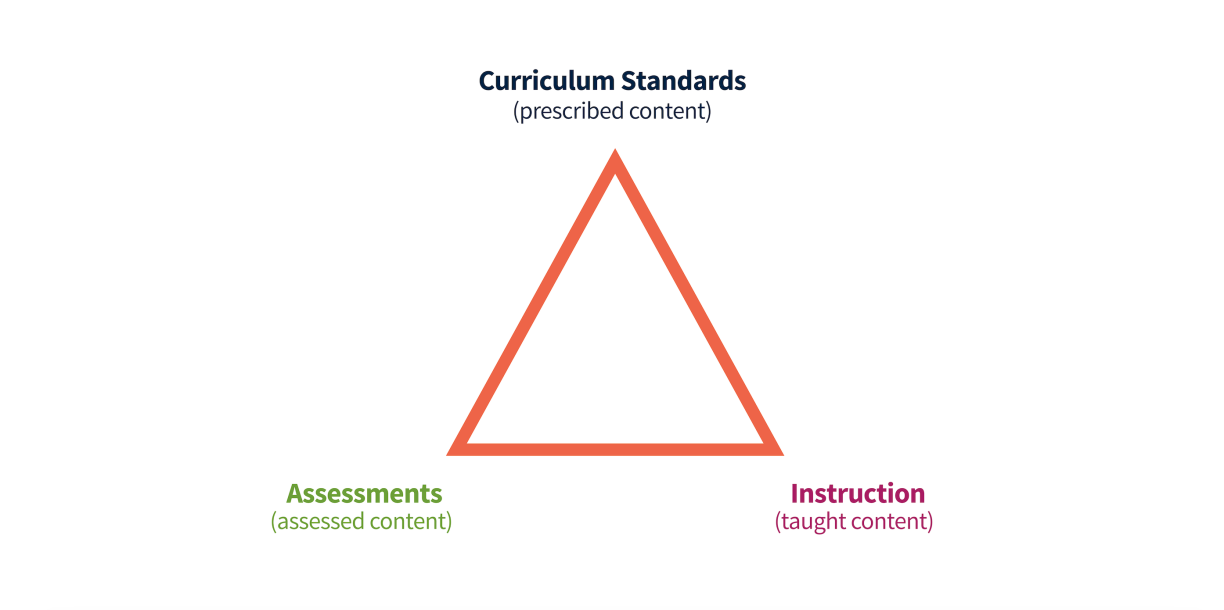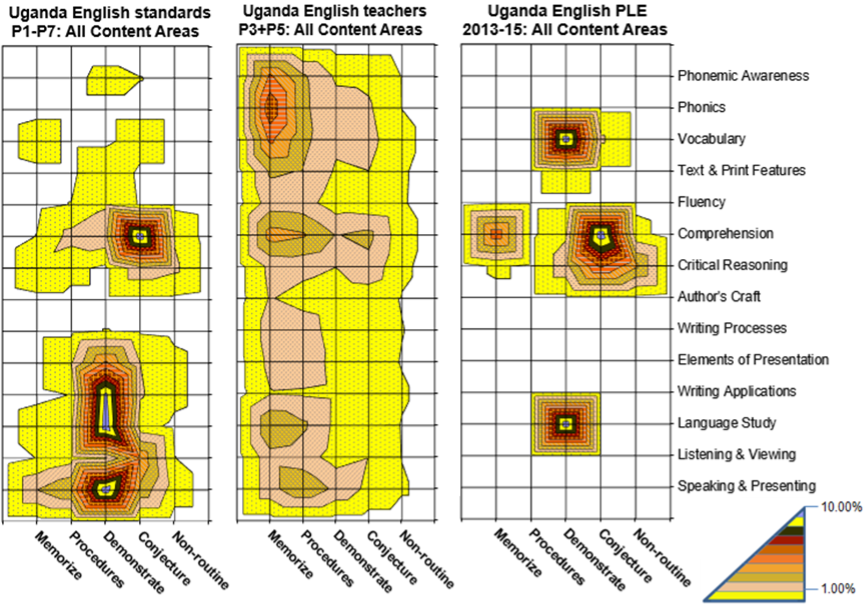Surveys of Enacted Curriculum
The Surveys of Enacted Curriculum approach is used to analyse and report on the academic content embedded in education instructional components such as curriculum standards, assessments, and teachers’ classroom instruction.
Instructional misalignment is common in educational settings. Schools and teachers are expected to complete many tasks, such as completing the prescribed curriculum content and preparing children for high-stakes examinations. However, the content that teachers are expected to cover, for example, is often poorly aligned across components and poorly aligned with children’s learning needs.
The Surveys of Enacted Curriculum (SEC) methodology offers a way to systematically analyse and quantify the academic content and level of alignment and misalignment across instructional components, and to identify ways to improve alignment for learning.
Figure 1: Ideally, instructional components would be well-aligned with each other and with students’ learning needs.

About the SEC methodology
The SEC methodology allows users to systematically identify, quantify, and communicate about the academic content and level of alignment and misalignment across instructional components in an education system, in a manner that is data-driven and empirical.
Outputs from an SEC study include user-friendly visualisations of the content embedded within instructional components, along with indices quantifying the degree of (mis)alignment between instructional components. The SEC methodology also describes content progression over time and across grades, bringing concreteness to the concept of curricular and instructional pace. All of this facilitates the diagnosis of areas in which content alignment or progression could be improved to support learning.
The SEC approach was developed by researchers at the University of Wisconsin who later formed the Center for Curriculum Analysis. It has been applied in Kenya, Uganda, Tanzania, Nepal, Nigeria, Egypt, and throughout the United States.
Figure 2: A visualisation of alignment between Ugandan primary school English curriculum standards, teachers’ classroom instruction, and primary leaving exams.

Note: Visualisations represent 3-dimensional content maps. Instructional topics are on the Y axis, levels of cognitive demand on the X axis, and level of emphasis on the Z axis. The panels show Ugandan English curriculum standards aggregated for Grades 1–7 (Panel 1), Ugandan English teacher instruction aggregated for Grades 3 and 5 (Panel 2), and aggregate Ugandan English primary leaving exams from 2013 to 2015 (Panel 3).
For more on the SEC methodology, see this short video from RISE Research Fellow Julius Atuhurra:
Findings from SEC studies in low- and middle- income countries
Through a partnership between the RISE Programme and the Center for Curriculum Analysis, the SEC approach has been used to analyse educational alignment in low- and middle-income country education systems. In East Africa (Kenya, Tanzania, and Uganda) and West Africa (Nigeria), the methodology was used to analyse education system alignment, in studies led by Twaweza East Africa and the Centre for the Study of the Economies of Africa respectively. In South Asia (Nepal), the methodology was used to understand the implementation of a new integrated curriculum, in a study led by RTI International.
These studies suggest that misalignments between curriculum, classroom instruction, and assessments are commonplace. For findings from each study, see:
East Africa (Kenya, Tanzania, and Uganda):
Atuhurra, J. and Kaffenberger, M. 2022. Measuring education system coherence: Alignment of curriculum standards, examinations, and teacher instruction in Tanzania and Uganda. International Journal of Educational Development: Vol 92. https://doi.org/10.1016/j.ijedudev.2022.102598.
South Asia (Nepal):
Atuhurra, J., Chaudhry, R., Hossain, T. and Kaffenberger, M. 2023. Instructional Alignment in Nepal Using the Surveys of Enacted Curriculum. 2023/057. https://doi.org/10.35489/BSG-RISE-RI_2023/057
West Africa (Nigeria):
Adeniran, A., Atuhurra, J., Chaudhry, R., Kaffenberger, M., Okon, A., and Onyekwere, S. [Forthcoming]. Instructional alignment in Nigeria using the Surveys of Enacted Curriculum. RISE Working Paper Series
The SEC toolkit
The RISE Programme has developed a toolkit for conducting SEC studies in low- and middle- income countries. The toolkit is designed specifically for policymakers, researchers, and education practitioners.
The toolkit serves as an implementation guide for using the SEC approach to understand the alignment and misalignment of an education system’s key instructional components. Further, the toolkit reflects lessons learned from applying the SEC methodology in the five low- and middle- income country contexts described above.
The toolkit can be accessed using the links below.
- The complete toolkit [PDF]
- Atuhurra, J., Chaudhry, R. and Kaffenberger, M. 2023. Conducting Surveys of Enacted Curriculum Studies in Low- and Middle- Income Countries: A Toolkit for Policymakers, Researchers, and Education Practitioners. Research on Improving Systems of Education. https://doi.org/10.35489/BSG-RISE-Misc_2023/13
- An overview of the toolkit (slide deck) [PDF]
- Toolkit appendices [.zip]
